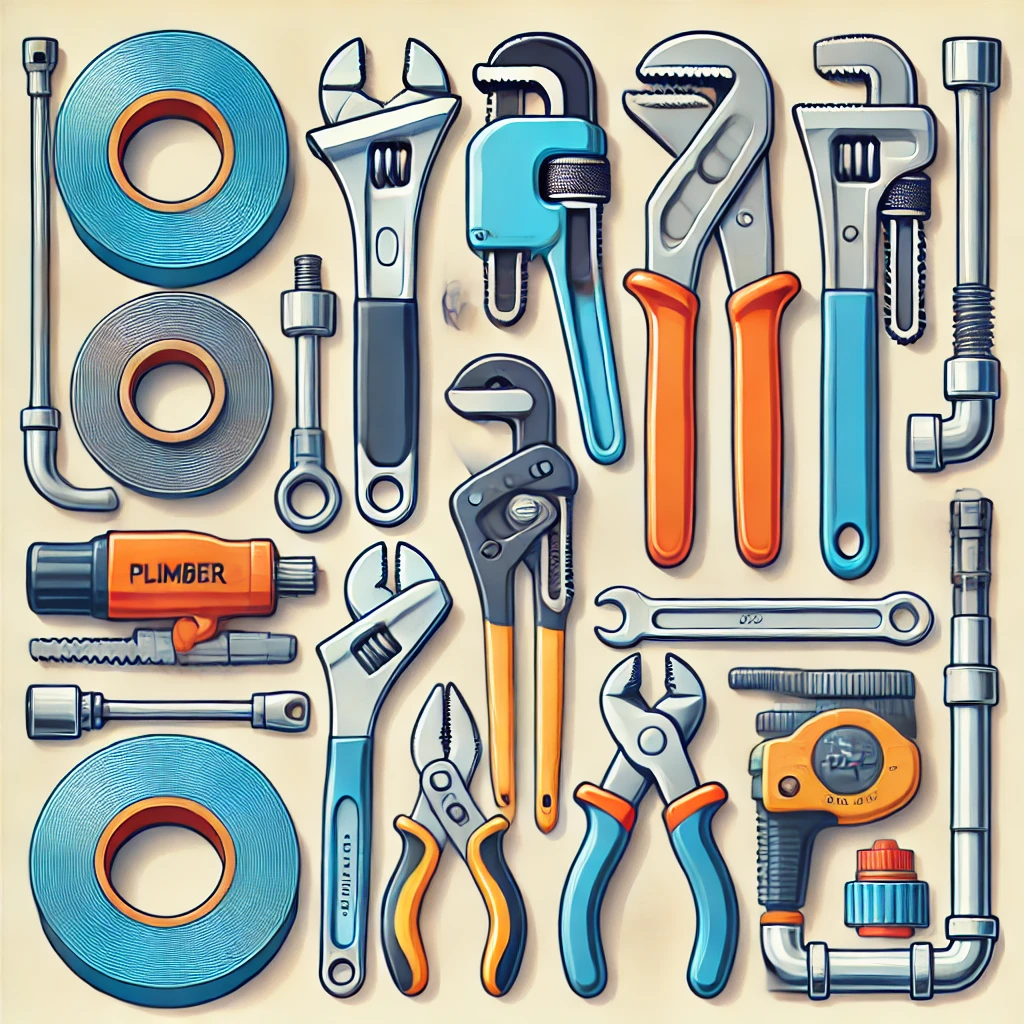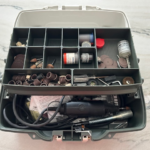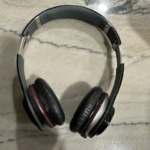Tackling minor plumbing issues at home can save you money and give you a sense of accomplishment. But to do it safely and effectively, you’ll need the right tools. In this post, we’ll discuss the essential plumbing tools every DIYer should have in their toolkit.
Basic Essential Plumbing Tools
Adjustable Wrench
The adjustable wrench is one of the most versatile tools in any DIYer’s toolkit, and it’s a must-have for plumbing projects. Unlike fixed wrenches, an adjustable wrench can be resized to fit a variety of nuts and bolts, making it ideal for working in tight spaces where multiple sizes of wrenches would be impractical. Its smooth jaws help to prevent damage to pipes and fittings, especially those made of softer materials like copper. Whether you’re tightening a loose connection or adjusting a fitting, the adjustable wrench offers both precision and convenience, making it an essential tool for DIY plumbing tasks.
Recommendation:
Pipe Wrench
The pipe wrench is a heavy-duty tool designed for gripping and turning pipes, making it indispensable for many plumbing projects. Known for its strong jaws and adjustable design, the pipe wrench is ideal for tightening or loosening threaded pipes, particularly in plumbing systems where a strong grip is essential. The serrated teeth of the wrench provide extra leverage, allowing you to securely grip round objects like pipes without slipping. However, due to its strength, it’s important to use a pipe wrench carefully to avoid damaging softer pipes or fittings. Whether you’re working on a leaky pipe or installing new plumbing, the pipe wrench is a go-to tool for any serious DIYer.
Recommendation:
Pliers
Pliers are an essential, multifunctional tool in any DIY plumber’s toolkit, offering both grip and leverage for a wide range of tasks. Whether you’re tightening or loosening nuts and bolts, holding small components in place, or bending wires, pliers provide the control you need for precise work. Different types of pliers, such as slip-joint, needle-nose, and tongue-and-groove, are useful for various plumbing tasks. Slip-joint pliers are great for general use, while needle-nose pliers help with reaching tight spaces and handling smaller parts. With their versatility and ease of use, pliers are a reliable tool for any plumbing project, helping you get a firm grip on the job at hand.
Recommendation:
Screwdriver
The screwdriver is a simple yet essential tool in plumbing, often overlooked but critical for completing various tasks. Whether you’re tightening screws on pipe clamps, securing faucet handles, or assembling fixtures, a screwdriver is indispensable. Both flathead and Phillips head screwdrivers are commonly needed in plumbing projects, depending on the type of fasteners you’re working with. Having a set of screwdrivers in various sizes ensures that you can handle any job, no matter how small. The precision and control provided by a quality screwdriver make it a key player in ensuring that your plumbing repairs and installations are secure and long-lasting.
Recommendation:
Plumber’s Tape
Plumber’s tape, also known as Teflon tape, PFTE tape, or thread seal tape, is a vital tool in ensuring leak-proof connections in plumbing projects. This thin, flexible tape is typically wrapped around the threads of pipes and fittings before they are screwed together. Its primary function is to create a tight seal that prevents water or gas leaks by filling in any gaps between the threads. Plumber’s tape is easy to use and works well with a variety of materials, including metal and plastic pipes. Whether you’re installing new fixtures or repairing old ones, plumber’s tape is a simple yet effective way to ensure that your connections stay secure and leak-free.
Recommendation:
Pipe Cutter
A pipe cutter is a specialized tool designed to make clean, precise cuts through various types of pipes, such as copper, PVC, and steel. Unlike a hacksaw, which can leave rough edges, a pipe cutter provides a smooth, even cut, making it the preferred tool for many plumbing projects. Depending on the material you’re working with, pipe cutters come in different styles, including manual and automatic versions. They are easy to use—simply tighten the cutter around the pipe and rotate it until the pipe is severed. Whether you’re replacing a section of pipe or customizing the length of a new installation, a pipe cutter ensures that your cuts are accurate and clean, which is essential for a proper fit and a leak-free connection.
Recommendation:
Specialized Essential Plumbing Tools
Basin Wrench
The basin wrench is a unique and indispensable tool for working in tight, hard-to-reach spaces, particularly under sinks. Designed specifically for loosening and tightening nuts that hold faucets to sinks, its long, narrow shaft and pivoting head allow it to access areas where a standard wrench simply won’t fit. The basin wrench’s spring-loaded jaw grips nuts securely, making it ideal for tasks like replacing faucets or repairing leaks. While it’s a specialized tool, the basin wrench is crucial for DIY plumbing enthusiasts tackling sink installations or repairs, saving you time and frustration in otherwise difficult spaces.
Recommendation:
Drain Snake
A drain snake, also known as a plumber’s snake or hand auger, is a vital tool for clearing tough clogs in drains that a plunger can’t handle. It consists of a long, flexible cable with a coiled head designed to navigate through pipes and break up blockages. Drain snakes are particularly effective for deeper clogs in sinks, bathtubs, and toilets, where hair, soap scum, and debris can build up over time. By inserting the snake into the drain and cranking the handle, you can push through the obstruction and restore proper water flow. For DIY plumbing enthusiasts, a drain snake is an essential tool that can save you from costly professional drain-cleaning services.
Recommendation:
Faucet Key
A faucet key is a small but essential tool used for opening and closing outdoor spigots, hose bibs, and sillcocks that don’t have traditional handles. It’s typically a simple, T-shaped or cross-shaped device that fits over the square or hexagonal valve stem of the faucet. Faucet keys are often needed in commercial or industrial settings, or in older homes, where standard faucet handles may be absent for security reasons. By using a faucet key, you can easily control water flow to outdoor faucets, making it an indispensable tool for tasks like garden watering, filling pools, or draining outdoor water systems before winter. Having a faucet key in your plumbing toolkit ensures that you’re always prepared for outdoor water needs.
Recommendation:
Toilet Plunger
A toilet plunger is a must-have tool for every household, designed specifically to tackle clogs in toilets. Unlike a standard cup plunger, a toilet plunger has a flange at the bottom that creates a better seal over the toilet drain, providing the necessary suction to dislodge blockages. It’s simple to use—just place the plunger over the drain and push down gently before pulling back up to create a vacuum effect. This action forces water and air through the pipe, breaking up the clog and restoring normal flow. Having a good-quality toilet plunger on hand can save you from costly plumber visits and is often the first line of defense against minor toilet clogs.
Recommendation:
Safety First
Safety should always be your top priority when tackling any DIY plumbing project. Before starting, make sure you have the proper protective gear, including gloves, safety goggles, and appropriate footwear. Always turn off the water supply before working on pipes to avoid leaks or flooding. Be cautious when handling sharp tools like pipe cutters and wrenches, and never underestimate the risks of working with water and electricity in the same space. If you’re unsure about any part of the project, don’t hesitate to consult a professional—safety always comes first!
Choosing the Right Essential Plumbing Tools for Your Project
Not every plumbing project requires a full arsenal of tools, so it’s essential to assess the job at hand and choose the right tools accordingly. The first step is identifying the scope of your project. Are you dealing with a simple clog, or are you replacing a section of pipe? Understanding the specific demands of your task will help you determine which tools are necessary.
For smaller, more common jobs like unclogging a drain or tightening a leaky faucet, you may only need basic tools like a plunger, an adjustable wrench, and some plumber’s tape. On the other hand, larger projects, such as installing a new sink or repairing broken pipes, will require more specialized tools like a basin wrench, a pipe cutter, and PVC pipe glue.
Consider the material of the pipes you’re working with as well. PVC, copper, and galvanized steel pipes each have their own requirements when it comes to cutting, sealing, and joining. For instance, a pipe cutter for copper pipes won’t be as effective on PVC, and vice versa. Always double-check that the tools you have are compatible with the materials in your home.
Investing in high-quality tools is also crucial. While it may be tempting to go for the cheapest option, remember that durable tools will save you time, money, and frustration in the long run. A sturdy pipe wrench that won’t slip, or a reliable pipe cutter that makes clean cuts, can make all the difference in the success of your project.
In short, the key to choosing the right tools lies in understanding your specific project needs and investing in tools that will get the job done efficiently and safely. Taking the time to select the proper equipment will ensure smoother, more successful DIY plumbing projects.
Proper Essential Plumbing Tools Maintenance
Once you’ve invested in essential plumbing tools, proper maintenance is key to ensuring they stay in good working condition for years to come. Well-maintained tools not only perform better but also save you money by reducing the need for frequent replacements. Here’s how to keep your plumbing tools in top shape:
- Clean Your Tools After Every Use
Dirt, grime, and rust can quickly accumulate on plumbing tools, especially after handling wet or dirty jobs. After each use, take a few minutes to clean your tools. Wipe them down with a clean cloth to remove any moisture, dirt, or debris. For tools like wrenches and pliers, use a brush to clean out any grooves or joints where debris may have collected. - Prevent Rust and Corrosion
Plumbing tools are often exposed to water, making them susceptible to rust. To prevent rust and corrosion, dry your tools thoroughly after cleaning them. You can also apply a light coat of oil to metal parts to protect them from moisture. If you notice any rust starting to form, use a rust remover or fine sandpaper to clean it off before it spreads. - Inspect Tools Regularly
Regular inspection of your tools can help you catch any signs of wear and tear early. Check for loose screws, worn-out parts, or any damage that could affect the tool’s performance. For cutting tools like pipe cutters, make sure the blades are sharp and free from nicks. If a tool is damaged beyond repair, it’s better to replace it than to risk using something that could fail mid-project. - Proper Storage
Storing your tools properly is just as important as cleaning them. Keep your tools in a dry, cool place to avoid exposure to moisture and extreme temperatures, which can cause damage over time. Consider using a toolbox or tool organizer to keep everything in one place and prevent tools from getting lost or damaged. For small tools, hanging them on a pegboard can keep them easily accessible and neatly stored. - Sharpen and Lubricate as Needed
Certain tools, like pipe cutters and augers, require periodic sharpening to maintain their effectiveness. Dull blades or cutting edges can make a job harder and increase the risk of mistakes. Lubricating moving parts, such as the joints of pliers or the adjustable mechanisms of wrenches, will ensure smooth operation and extend the tool’s life.
By following these simple maintenance practices, you’ll ensure that your essential plumbing tools are always ready when you need them. Not only will they last longer, but they’ll also make your DIY projects easier and more efficient. Proper care today will save you time, money, and hassle down the road.
Conclusion
Having the right tools is essential for any DIY plumbing enthusiast. From the versatile adjustable wrench to the specialized basin wrench, each tool serves a unique purpose that can make your projects more efficient and successful. Proper maintenance of your tools will ensure they last for years, and knowing when to call a professional can save you from potential headaches and costly mistakes. Whether you’re tackling a simple leak or a more complex installation, being prepared with the essential plumbing tools will give you the confidence to handle whatever challenges come your way. So, equip your toolkit, follow safety guidelines, and dive into your next DIY plumbing project with the assurance that you’re ready to succeed!








Leave a Reply